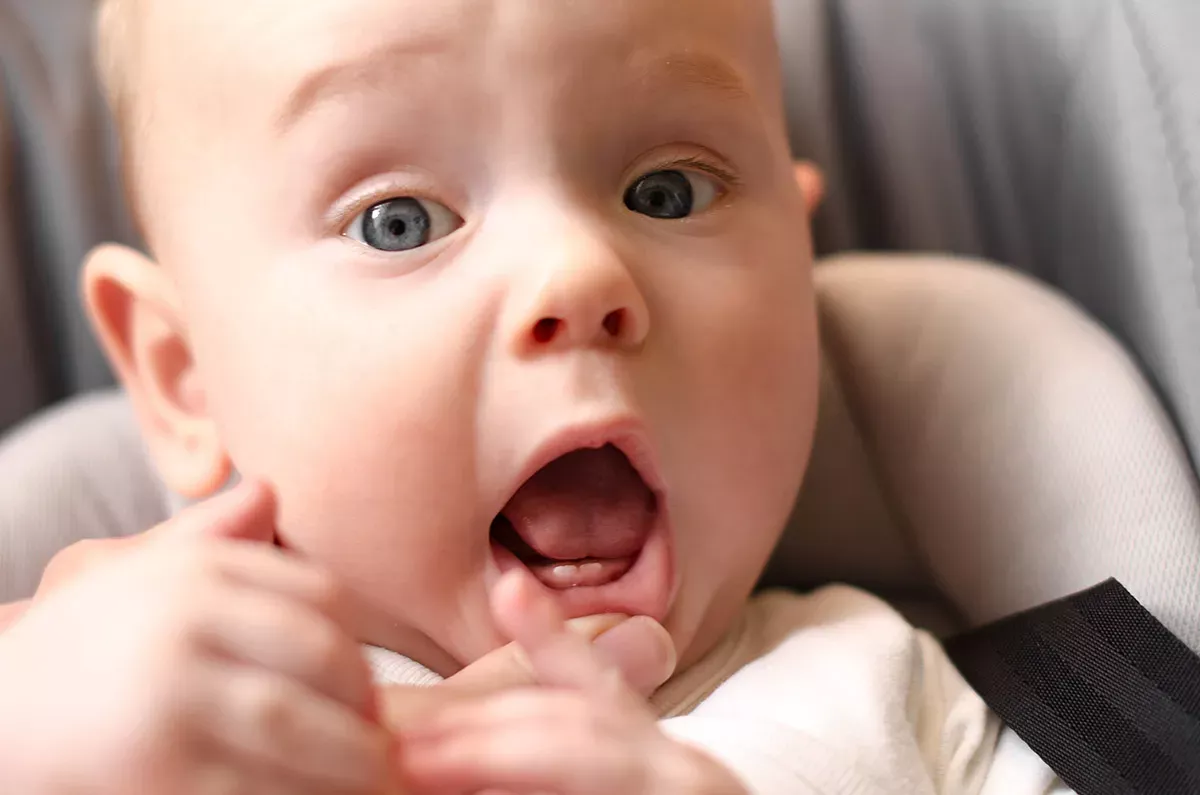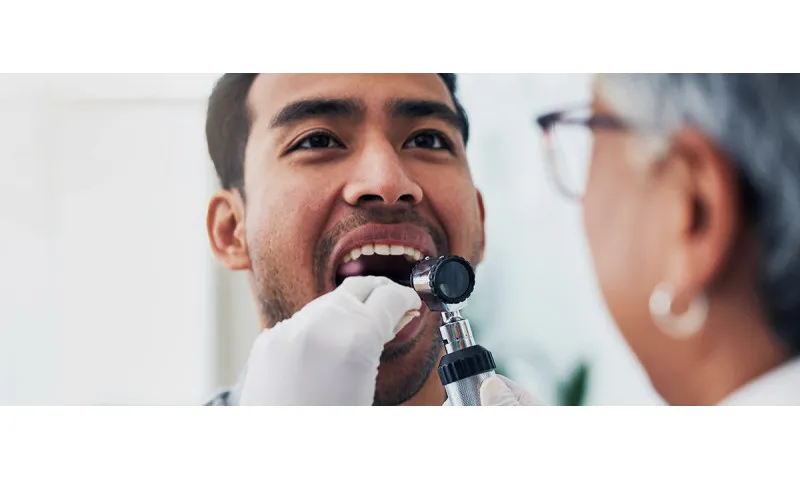When do babies start teething?
When a baby's first teeth appear is very individual. On average, the first tooth appears between the sixth and eighth month. However, it can happen that the first signs of teething appear as early as three months. Parents need not worry if it takes a little longer for their baby's first tooth to appear. However, most babies have at least one tooth in their mouth by their first birthday. If your baby is still completely toothless after 18 months, you should make an appointment with the dentist as a precaution.
What is particularly exciting is that the baby does not develop its first teeth after birth. Between the sixth and eighth week of pregnancy - i.e. quite early in the pregnancy - the germinal centres for all teeth are already developing. At birth, the crowns of the milk teeth are fully formed - but still hidden in the jaw. The crown is the part of the tooth that is visible after eruption. However, the roots still have to develop and are fully formed after 1.5 to 3 years.
Good to know:
Did you know that pregnancy can affect your oral health? Find out here what you need to pay particular attention to:
How long do babies teethe?
When the first teeth come in and how long babies teethe is very individual - but the order in which babies get teeth is less so. The eruption of teeth usually follows a fairly standardised pattern: the baby's first teeth are the lower central incisors, followed by the upper central incisors. Next in line are the lateral incisors. Often all eight incisors have erupted around the first birthday. This is followed by the first molars and then the canines. The last teeth are the back molars. By the age of two and a half, most children have a complete set of milk teeth with 20 teeth in their mouths - although some children already have them at 20 months.
As a rough rule of thumb, a baby gets a new tooth every month after the first tooth erupts. However, it can happen that teeth come in at the same time.
How long does teething take per tooth?
The length of time it takes for each tooth to erupt can vary considerably. Teething discomfort often begins four days before eruption and can continue for three days afterwards. Including the day of eruption, there are therefore eight days on which your baby can suffer from teething discomfort. This was the conclusion of a study by the American Academy of Paediatrics. If you convert this to all milk teeth, your baby will be busy with the eruption of the first teeth for up to 160 days in total.
Good to know:
The development of permanent teeth begins while your baby is still crawling. Find out what you and your child can expect in a few years' time when the teeth change here:
Teething in babies: First signs and symptoms
You're probably wondering how you can recognise teething. While parents are still unsure about their first baby and teeth, experienced parents find it easy to recognise the typical signs of teething in their baby. Again, every baby is different. Not all teething symptoms necessarily occur in your baby. Some babies get through the teething period relatively easily and without much discomfort, while others suffer extremely.
You can often tell when a baby is teething by its behaviour: It is usually clingier and whinier than usual. It cries more than in previous months and needs more attention. Most babies sleep more restlessly when teething because they have fewer distractions at night and are more aware of the pain. However, it can also happen that a baby sleeps a lot when teething. Due to the pain, your baby may not drink much when they are teething. This refusal to eat is often interpreted as a loss of appetite.
However, there are also some physical symptoms that can occur when your baby is teething: Saliva flows freely and often runs down the corners of the mouth, which can make the mouth dry and sore. Clothes also often get soaked. Because the mouth is supplied with more blood, babies often get red cheeks that feel hot when teething - especially on the side on which the new tooth breaks through. The gums itch, burn and tighten. They are often reddened and swollen. As counter-pressure alleviates the symptoms, babies put all kinds of objects they can get their hands on into their mouths to chew on them when teething. Some babies also rub their gums with their hands.
Diarrhoea and fever during teething: Accompanying symptom or infection?
For a long time, it was thought that fever and diarrhoea were part of teething symptoms. Today, it is assumed that teething weakens the baby's immune system to such an extent that it is more susceptible to infections with fever and diarrhoea. Although teething can lead to an increased body temperature of 38 degrees, if your baby or toddler's fever rises to over 39 degrees, this is most likely not related to teething and should be checked by a paediatrician. Cold sweat during teething is also an indication of fever and an infection. The same applies to diarrhoea during teething: If your baby suffers from diarrhoea for more than a day when teething, you should go to the paediatrician as a precaution because it is probably an infection.
What do the gums look like when babies are teething?
If the above symptoms apply, there is a very high probability that your baby is teething. However, many parents - especially with the first baby and the first tooth - want solid evidence to be sure. So is it possible to recognise the "culprit" when the tooth erupts? Yes and no. When the tooth is about to erupt, babies often have swollen and reddened gums. You may then be able to see a small bump and feel the tooth underneath. However, babies can also experience pain before the tooth is visible and noticeable.
Does every baby have pain when teething?
No, not necessarily. Although it is rare for a baby to have no pain at all when teething, it can certainly happen. For most babies, however, teething is painful or at least unpleasant. However, the degree of pain varies greatly from person to person. Some babies scream in pain all day, while others are just a little more clingy and whingy.
What complications can occur during teething?
In most cases, the eruption of a baby's tooth is free of complications. However, it is possible for an eruption cyst to develop. This is a bluish, bulging blister that normally bursts by itself when chewing on objects. Breakthrough cysts are harmless and rarely need to be opened by a dentist.
Another possible complication is "difficult tooth eruption", in which purulent inflammation forms in the gum pocket around the tooth. If the area bleeds or suppurates with slight pressure, you should take your baby to the dentist as a precaution.
Good to know:
Adults should also take inflamed gums seriously. After all, untreated gingivitis can have serious consequences. You can find everything you need to know about gingivitis here:
Baby teething: What helps?
When your little one is suffering and crying, it's hard to bear as a mum or dad. So what can you do when your baby is teething? We have put together the most helpful tips for you here to alleviate teething discomfort.
Bite ring
If you want to help your baby with teething, a high-quality teething ring is the best choice. The counter-pressure when biting on it relieves the pain. Make sure you choose a model without harmful substances such as bisphenol A (BPA), phthalates or azo dyes so that you can let your baby chew on it to their heart's content. Incidentally, babies find chilled teething rings particularly pleasant because the cold soothes swollen and irritated gums. Important: Please only cool teething rings in the fridge - never in the freezer. Otherwise there is a risk of damaging the gums. Ice cubes are also unsuitable for babies.
When can you start giving babies a teething ring?
In principle, you can give your baby a teething ring as soon as they can grasp it. Babies often only develop a real interest in this when they start teething and are looking for things to chew on. If your baby prefers to chew on soft objects rather than hard ones, you can also offer them a cold, well-wrung flannel (and change it several times a day). For a soothing effect, you can soak the flannel in cold sage or camomile tea instead of water.
Good to know:
The teething ring from Curaprox not only relieves teething pain by massaging the sensitive gums. It also introduces your baby to brushing their teeth in a playful way with the mini practice toothbrush and promotes sensory and motor skills with various exciting surfaces. Naturally free from harmful substances.
Gum massage
If you want to pamper your baby during teething and provide pleasant counter-pressure to the erupting tooth, you can give them a gum massage. To do this, wash your hands well and gently massage the gums with your fingers. You can also dab some cooled chamomile or sage tea onto the gums and massage in gently. A soft baby toothbrush (such as the baby toothbrush from Curaprox) is also ideal for the massage.
Pain-relieving gels
Pharmacies sell special tooth gels with an analgesic and anti-inflammatory effect that you can apply to the affected area. These gels are designed to temporarily reduce itching and pain. These gels often contain herbal ingredients such as camomile, sage, clove or peppermint oil. If the pain is very severe, a teething gel with a local anaesthetic effect can also be used. It is best to seek advice on this from your paediatrician and pharmacy.
Change neckerchief frequently
As the baby drools a lot when teething, the clothes around the neck and chest are often soaked. To prevent this, you can use an absorbent scarf or a waterproof bib so that you don't have to keep changing your baby and they don't catch a cold. You can use a scarf to quickly dab your baby's mouth or let them chew on it. It's best to have several wipes to hand so that you can change them quickly.
Lots of love, attention and patience
Even if it can be stressful for parents: The best remedy for teething babies is lots of love, attention and patience. The little new earthlings are going through a lot now and are dependent on the help of their loving parents. Comfort your baby when it cries, hold it in your arms, cuddle it and give it security. This may be temporarily exhausting, but it is only a phase that will pass. Affection and security are the best basis for healthy development.
What helps with teething at night?
If the pain is particularly severe and your baby can't sleep a wink, painkillers can provide relief. However, these should only be used in phases of acute tooth eruption and not all the time. It is best to seek advice from your paediatrician.
Better not: controversial home remedies for teething
There are a number of home remedies that are widely used but not necessarily harmless:
Hard food
In some parenting forums, hard foods such as carrots, apples and bread crusts are recommended as a teething aid. However, there is a risk that a piece will break off and your baby will choke - and in the worst case, choke on it. In addition, these foods contain sugar and can cause tooth decay if chewed constantly. A teething ring is much safer. If you still want to give your baby hard food to chew, you should never leave them unattended.
Good to know:
Did you know that tooth decay is contagious? If you put the baby spoon or dummy first in your mouth and then in your baby's mouth, you run the risk of transferring your tooth decay bacteria to your baby. You can find everything you need to know about tooth decay here:
Violet root
Some midwives recommend giving babies violet roots to chew because they have an analgesic effect. This may initially sound like a natural alternative to a teething ring, but unfortunately it is not hygienic. Bacteria and other germs can easily collect on the roots. The wood is also much more difficult to clean than a teething ring. If you still want to use this home remedy, you should boil the roots regularly and allow them to dry thoroughly.
Amber necklaces
Amber necklaces are said to make teething easier. However, they harbour quite a lot of potential danger: babies can tear the chains around their necks and possibly swallow individual stones or injure their mouths. However, they can also strangle themselves with the chain and, in the worst case, suffocate. Paediatricians therefore strongly advise against using amber necklaces when teething.
Dental care from the first tooth
Hooray! Your baby's first tooth has arrived! And now what? Now it's time for dental care. Because the little baby teeth are still relatively soft and particularly sensitive. Because the enamel on milk teeth is only half as thick as that on permanent teeth, caries bacteria have a particularly easy time of it. That's why brushing your baby's teeth as soon as their first tooth comes through is a must - twice a day (morning and evening) with a special baby toothbrush (such as the baby toothbrush from Curaprox) and toothpaste for children (such as the Kids Strawberry toothpaste from Curaprox).
Good to know:
The first tooth raises lots of questions: How long should you brush your baby's teeth? With what? When should you start using toothpaste? Which toothpaste is suitable for babies? And what if they don't want to brush their teeth? You can find all the answers here:
When should I take my baby to the dentist?
Once your baby has had their first teeth, you can also plan their first visit to the dentist. It's up to you whether you do this immediately after the first tooth comes through or around the time of the first birthday. The important thing is that the dentist gets to see the little teeth early to see if everything is in order. You can also get your baby used to the fact that a visit to the dentist is something completely normal.
Sources
Birkholz, Nathalie: Tooth eruption - What does it look like? on: eltern.de.
Federal Centre for Health Education: The development of teeth, a healthy diet and the first teeth.
Dentolo: When your baby is teething: First symptoms & quick help.
Dossmann, Lita: Teething: This really helps your baby, at: zahnarztzentrum.ch.
Görz, Martina: Breakthrough in the mouth, on: diepta.de.
Paediatricians on the net: When do the first teeth appear and how can I help my child?
Maike Mauer: Baby teething: 7 first aid tips and answers to important questions, on: familie.de
Schmidt-Jortzig, Julia et al: Your baby is teething? Ouch! Here are the tips!, on: eltern.de
Swiss Mum: Teething.
All websites last accessed on 30.04.2024.
 Swiss premium oral care
Swiss premium oral care








